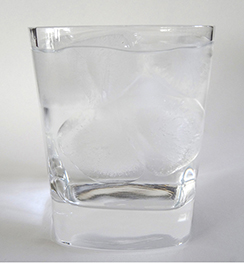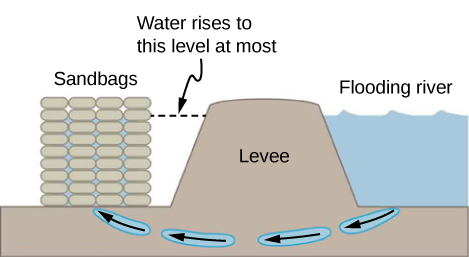| << Chapter < Page | Chapter >> Page > |
Which of the following substances are fluids at room temperature and atmospheric pressure: air, mercury, water, glass?
Mercury and water are liquid at room temperature and atmospheric pressure. Air is a gas at room temperature and atmospheric pressure. Glass is an amorphous solid (non-crystalline) material at room temperature and atmospheric pressure. At one time, it was thought that glass flowed, but flowed very slowly. This theory came from the observation that old glass planes were thicker at the bottom. It is now thought unlikely that this theory is accurate.
Why are gases easier to compress than liquids and solids?
Explain how the density of air varies with altitude.
The density of air decreases with altitude. For a column of air of a constant temperature, the density decreases exponentially with altitude. This is a fair approximation, but since the temperature does change with altitude, it is only an approximation.
The image shows a glass of ice water filled to the brim. Will the water overflow when the ice melts? Explain your answer.

How is pressure related to the sharpness of a knife and its ability to cut?
Pressure is force divided by area. If a knife is sharp, the force applied to the cutting surface is divided over a smaller area than the same force applied with a dull knife. This means that the pressure would be greater for the sharper knife, increasing its ability to cut.
Why is a force exerted by a static fluid on a surface always perpendicular to the surface?
Imagine that in a remote location near the North Pole, a chunk of ice floats in a lake. Next to the lake, a glacier with the same volume as the floating ice sits on land. If both chunks of ice should melt due to rising global temperatures, and the melted ice all goes into the lake, which one would cause the level of the lake to rise the most? Explain.
If the two chunks of ice had the same volume, they would produce the same volume of water. The glacier would cause the greatest rise in the lake, however, because part of the floating chunk of ice is already submerged in the lake, and is thus already contributing to the lake’s level.
In ballet, dancing en pointe (on the tips of the toes) is much harder on the toes than normal dancing or walking. Explain why, in terms of pressure.
Atmospheric pressure exerts a large force (equal to the weight of the atmosphere above your body—about 10 tons) on the top of your body when you are lying on the beach sunbathing. Why are you able to get up?
The pressure is acting all around your body, assuming you are not in a vacuum.
Why does atmospheric pressure decrease more rapidly than linearly with altitude?
The image shows how sandbags placed around a leak outside a river levee can effectively stop the flow of water under the levee. Explain how the small amount of water inside the column of sandbags is able to balance the much larger body of water behind the levee.

Because the river level is very high, it has started to leak under the levee. Sandbags are placed around the leak, and the water held by them rises until it is the same level as the river, at which point the water there stops rising. The sandbags will absorb water until the water reaches the height of the water in the levee.

Notification Switch
Would you like to follow the 'University physics volume 1' conversation and receive update notifications?